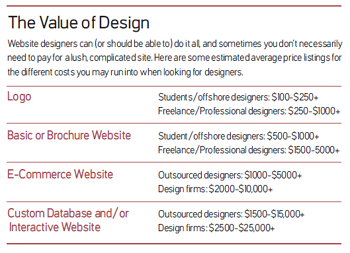Your Designer Makes What?!

 What You Need to Know Before Making Your Next Design Hire
What You Need to Know Before Making Your Next Design Hire
Once your business has decided that it's time to get in the game and create a website (and, in 2011, that shouldn't be a hard decision), it's time to face the daunting task of designing and creating the site that will introduce your brand to the Web.
This almost always means hiring someone to help you develop and build your site, and that can cost a lot of money.
An average estimate for a professionally designed multipage website is approximately $8,000 to $10,000. In a recent Website Magazine poll, the majority of respondents said that the cost of their latest Web design project was between $3,000 and $10,000.
Clearly, creating a great website can be a pricey endeavor, which is why you want to be aware of all of the factors involved before hiring a new designer.
KNOW WHAT TO LOOK FOR
When searching for a website designer, you are initially presented with a wide variety of options. The easiest way to narrow down your choices is to assess the skill level and value of the designer you want. Obviously, the more experienced your designer is, the higher up the pay scale you'll be moving, so it's good to know what you're getting involved with from the start. You can start by identifying five categories of designer: students, offshore/ outsourced designers, freelance professionals, independent firms and professional firms.  Design students and designers from countries outside of the U.S. are the cheapest form of labor, charging approximately $20 per hour for Web design projects. These are generally considered "discount" designers.
Design students and designers from countries outside of the U.S. are the cheapest form of labor, charging approximately $20 per hour for Web design projects. These are generally considered "discount" designers.
If you hire a freelance professional designer from the U.S., rates will jump to closer to $50 an hour, but these designers will also be able to provide you with a much larger body of their work so that you can better assess their skills.
"I'd say the best way is to browse Behance.net or any similar creative resource, as nothing speaks better for the designer as his or her portfolio," says Web designer Max Bratsun. "Personal connections may also act well for small businesses. And, finally, there are dedicated freelancing services like oDesk.com and 99designs.com for those who need the design to be done for less."
The next step up, small or independent firms, will more likely charge either a fixed rate or package deal rather than by the hour, although they've been known to do it all. Like freelance professionals, smaller firms are also considered mid-tier and thus charge comparable rates. Typically, choosing between the two becomes an issue of deciding between a more personal touch with freelancers or opting for more diversity with a firm.
For a considerably higher fee, you can also turn to a highlevel professional firm. Again, they'll likely charge you a flat fee or package rate as opposed to hourly (though it's not unheard of), and, on average, it's going to cost about twice as much to have a site designed by one of these companies than it would to go with a mid-tier independent designer. It should also be noted that if you happen to find an experienced freelance designer, the cost could come close to a professional firm but the general expectation is that individual designers tend to run cheaper.
KNOW WHAT TO PAY FOR
Without question, the most critical area when it comes down to pricing a website design project is the actual needs of your site. What does your company's website require? Will you have a custom Content Management System (CMS), a shopping cart platform, blog, Flash, forum or any number of other features? How many pages will you need?
You must be aware of these needs before even looking at designers, so first and foremost you need to sit down and decide what your site is going to look like and what it will be able to do.
Of course, there are a few things that you don't have much of a choice in and must be built into your site. The foundational elements of a website that will cost you some money include hosting, database design, business logic programming, markup, styling and graphics, standards-compliance, accessibility and testing, and continual maintenance.
You have to remember that when you're pricing these different features, you're paying for both the implementation and labor/time necessary to include them on your site. If you're paying a flat fee or package rate, then they are both already included in the price, but if you're paying hourly it can become costly if you're asking for a lot of bells and whistles.
"An hourly rate is the most transparent approach for both sides involved," says Bratsun. "However, the project manager should be a very well-skilled professional in order to provide the client with the real-life quote regarding the exact number of hours this or that milestone will take."
What it all comes down to is making sure you have the most efficient website for your company. Selecting an effective design and choosing the right designer for the job is a big undertaking, and often getting the best is not cheap. But in the end, the results should be worth the investment.
About the Author: Michael Garrity is an associate editor at Website Magazine, focusing primarily on search, design and development, and affiliate marketing.

Subscribe to Our Newsletter!
Latest in Web Design









